Florida has some of the finest fruit trees in the country. Growing good fruit means having hearty trees from which they fall. Florida’s best fruit trees are such a commodity that up to eight demand insurance coverage by the acre due to possible damage. Flooding, excessive moisture, freezing, or windy weather could cause drastic damage to these trees, resulting in millions of dollars and a lot less orange and grapefruit juice. That is why carefully growing and caring for any one of the fruit tree groves is vital for production and profit.
Fruit trees are temperate, with some preferring northern climates to tropical and subtropical climates in south Florida. Many of Florida’s most famous trees come from counties in the southern peninsula. Miami-Dade, Broward, and Palm Beach are popular places for plump fruit trees.
If growing and perfectly harvesting some of Florida’s fruit trees is not hard enough, the citrus produce must be cleared for sale by the federal government. All citrus fruit must be certified by the U.S.D.A. after thoroughly inspecting, treating, and waxing. Florida fruit trees are hearty from growth to sale, beating the heat and inspection to get into the hands of millions.
The list of the top 10 Florida fruit trees almost runs the alphabet, beginning with Avocado and ending with pomegranate, the all-star superfruit packed with antioxidants and anti-inflammatory properties.
While some Florida fruit trees are familiar, others are less. Some fruit trees produce round and plump produce, and others star-shaped deliciousness. Many of the trees have gorgeous tiny flowers while growing some of America’s favorite fruits. However you slice it, a bite of these freshly harvested pieces of Florida fruit will surely bring you back for more.
Read on to learn more about Florida’s 10 most popular fruit trees.
1. Avocado
Persea americana

Avocado trees thrive in warm weather, with Florida’s southern Miami-Dade and Collier counties producing the most bountiful harvest.
©lauraslens/Shutterstock.com
The small green fruit packed with flavor comes from the avocado tree. As guacamole’s base ingredient, avocado’s contribution to Mexican food is second to none but salsa. Three Florida avocado varieties are West Indian, Guatemalan, and Mexican. Florida is famous for producing West Indian and Guatemalan-West Indian hybrids. This Lauraceae family fruit tree groves abundant avocado groves in Miami-Dade and Collier counties; however, single trees are in warmer parts of the state. A member of the evergreen family, when entirely harvested, the avocado tree canopy is weighed down to the ground. When wholly harvested, the carambola tree varies in height and grows between 15-30 feet. Tiny yellow and green flowers with orange shoots decorate this fruit tree.
2. Carambola
Averrhoa carambola
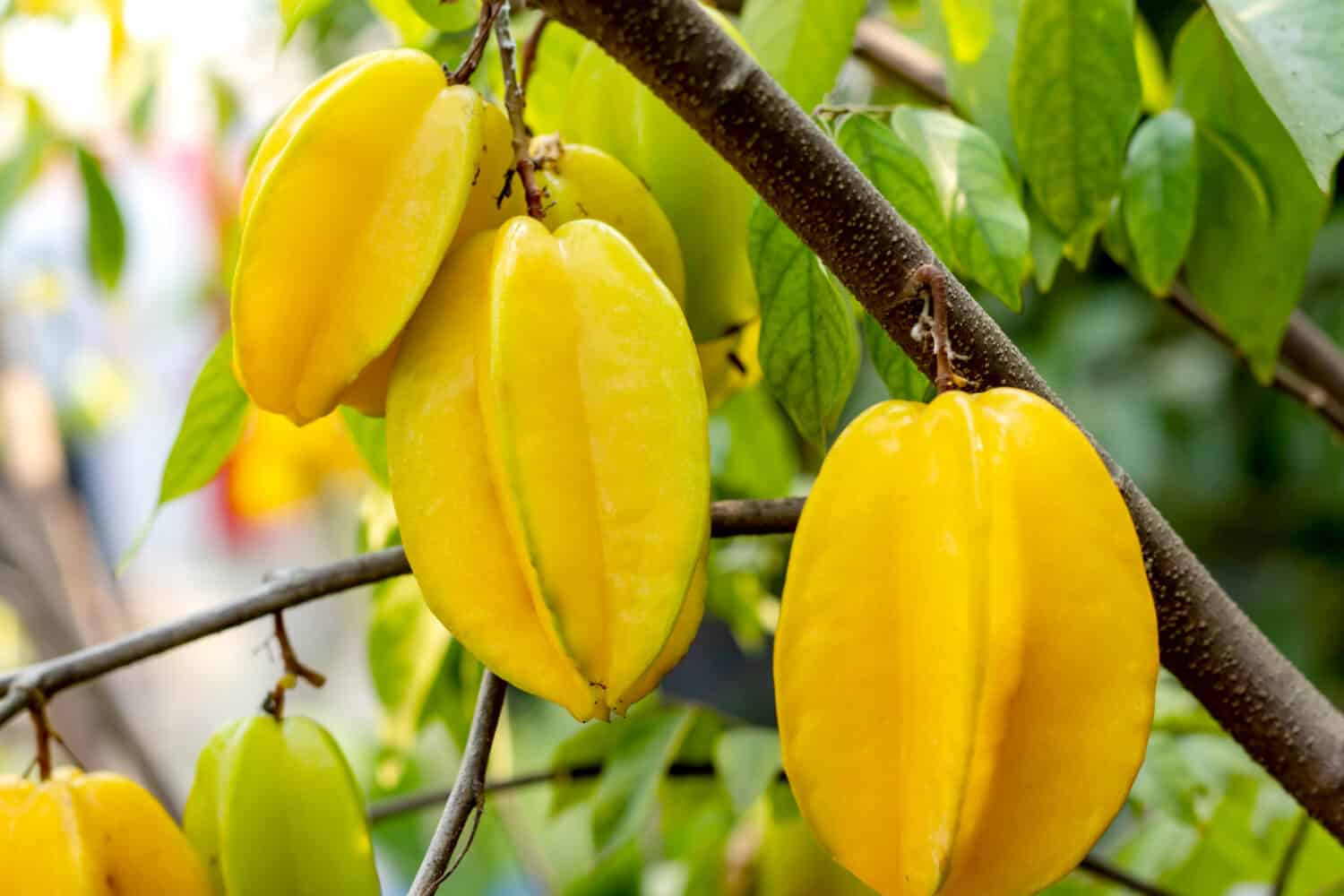
Carambola trees can grow up to 30 feet and need warm weather to produce their fruit, which resembles a star when cut in cross-section, hence its nickname of star fruit.
©Shutter Chiller/Shutterstock.com
The star-shaped fruit has an edible peel and seeds, making it even more unique than it looks. As part of the evergreen family, the carambola tree has been growing in the Sunshine State for up to a century. This fruit tree grows as high as 25-30 feet. Also called a bilimbi and five-finger, carambola fruit varies from sweet to tart, with the sweet type best eaten fresh. Commerical carambolas, also known as starfruit, from Florida are grown in four counties: Palm Beach, Broward, Lee, and Dade, all of which are warm. A carambola tree will not survive frost, with young leaves dying at 32 degrees and below. Too much wind can also hurt the dangling spiral-shaped fruit. The starfruit does not have a distinguishable flower but does come with a warning. Starfruit can be harmful due to certain toxins that affect the brain.
3. Grapefruit
Citrus x paradisi
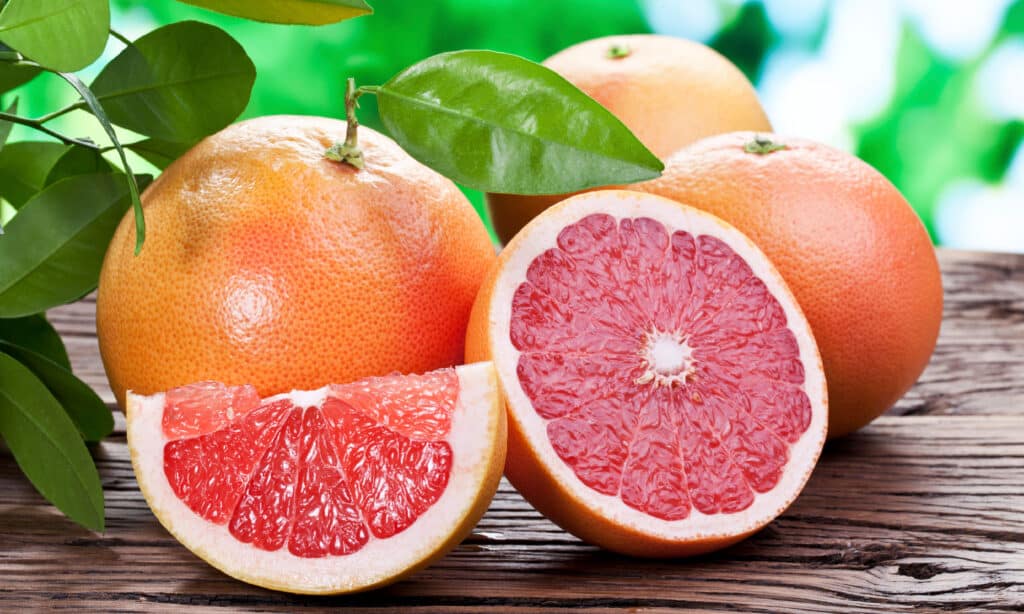
Grapefruit production has increased in the Sunshine State for the first time after nearly two decades of decline.
©iStock.com/ValentynVolkov
This Florida fruit tree yields the highest yearly citrus profit in America, selling thousands of boxes yearly and bringing billions annually to the Sunshine State. This fruit comes with a bright red middle and the tartest of taste. It is also white and called a pomelo that comes from the family of the Rutaceae tree. This Florida hardwood tree has an average height of 15-20 feet, bearing softball-sized fruit. An entirely harvested tree appears as a massive shrub on a small trunk with fruit sitting high and secure on solid branches. A recent increase in grapefruit production after the two-decade decline proves this Florida fruit tree is making a comeback. Like other citrus fruit trees, it bears a tiny white five-petal flower.
4. Lemon
Citus limon

Meyer lemons hang from a tree and are just as comfortable in cooler temperatures and will ripen throughout the winter months.
©RebeccaJaneCall/Shutterstock.com
The Florida fruit tree produces oblong yellow fruit used in many ways. The highly acidic fruit works when twisting its rind over a hot cup of espresso or squeezing one to make a cold glass of homemade lemonade. Its acidic nature is what makes it sensitive to any cold or frost, which is why Florida’s lemon tree grows strong and tall to 20 feet in Florida’s central and southern regions. But there is the more mellow-yellow Meyer lemon that does not mind the cold, with groves ripening throughout Florida’s winter months. Mellow yellow or not, this Rutaceae tree produces clusters of five-petal white flowers.
5. Lime
Citrus × aurantiifolia
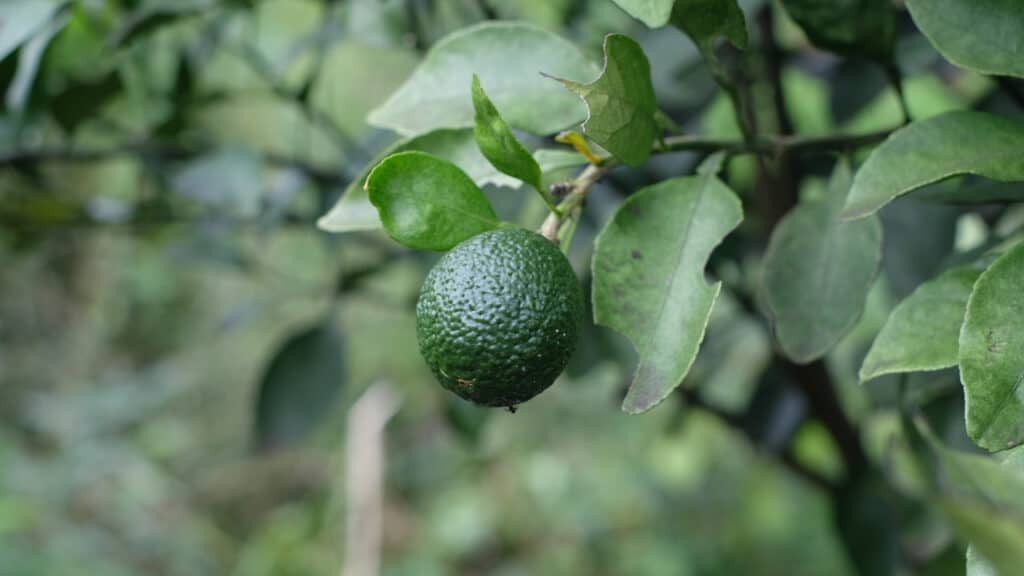
The Tahitian, or Persian, lime grows best in the southern part of the Sunshine State.
©LUCKY PEOPLE/Shutterstock.com
This Rutaceae tree produces a couple of popular lime types, beginning with the Tahitian, also known as Persian. This tiny round fruit packs a tart acid flavor that often compliments alcoholic beverages and desserts. This Florida lime is less popular than the Key lime, rightfully named for its hearty naturalization in the state’s southernmost tip. This lime best whipped in pie prefers subtropical Key West weather like the Persian. It also grows heartily in Miami-Dade, Orange, and Lake Counties. Lime tree flowers are tiny and white like lemons, sprinkling high through the tree, and can grow 15 to 20 feet.
6. Orange
Citrus × sinensis

Orange groves are bountiful in Florida, with dozens of varities contributing to the Sunshine State’s economy.
©iStock.com/paulobaqueta
Florida’s most famous fruit, representing the state’s fruit, beverage, and flower, the orange dominates the top crop list, not to mention it is the name of a color. Following Florida’s most famous Valencia orange are four other deliciously equal types: Ambersweet, Hamlin, Navel, and Pineapple. Different Florida orange types include the tangerine or tangelo, the cross between a tangerine and grapefruit. The rarest for orange kinds, the Kumquat is eaten with the skin. Depending on the type, orange trees, which come from the Rutaceae family, range from 12 to 30 feet, considered tall. These fruit tree groves are in Polk, DeSoto, Henry, and Highland Counties, as well as Indian River, Manatee, and Collier. All orange types have a dainty, white, and fragrant flower, brightening up the Florida fruit tree.
7. Jackfruit
Artocarpus heterophyllus
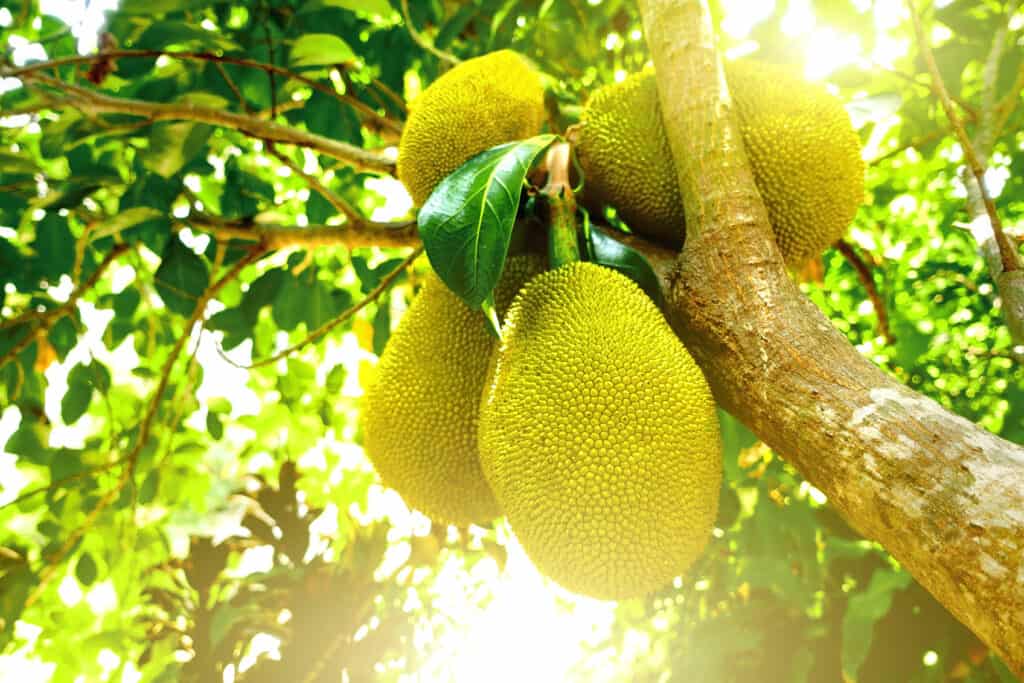
Jackfruit can weigh up to 10 pounds, making it able to withstands hurricane-force winds of Florida.
©ChockdeePermploysiri/Shutterstock.com
Exotic appearing like the Carambola, this short-trunked Florida fruit tree is a species native to Asia and has a first name. The large fruit, with prickly-appearing skin, may not be aesthetic, but its milky juice and edible seeds make up for it. The tree can grow as high as 70 feet and prefers subtropical weather and humid coastal regions. Jackfruit can be picked ripe in the summer and fall. This hearty and heavy fruit can weigh between three to 10 pounds each and take on hurricane winds with minor damage. The Jackfruit has both male and female thick green flower leaves rather than any popping flowers like other Florida fruit trees.
8. Mango
Mangifera indica
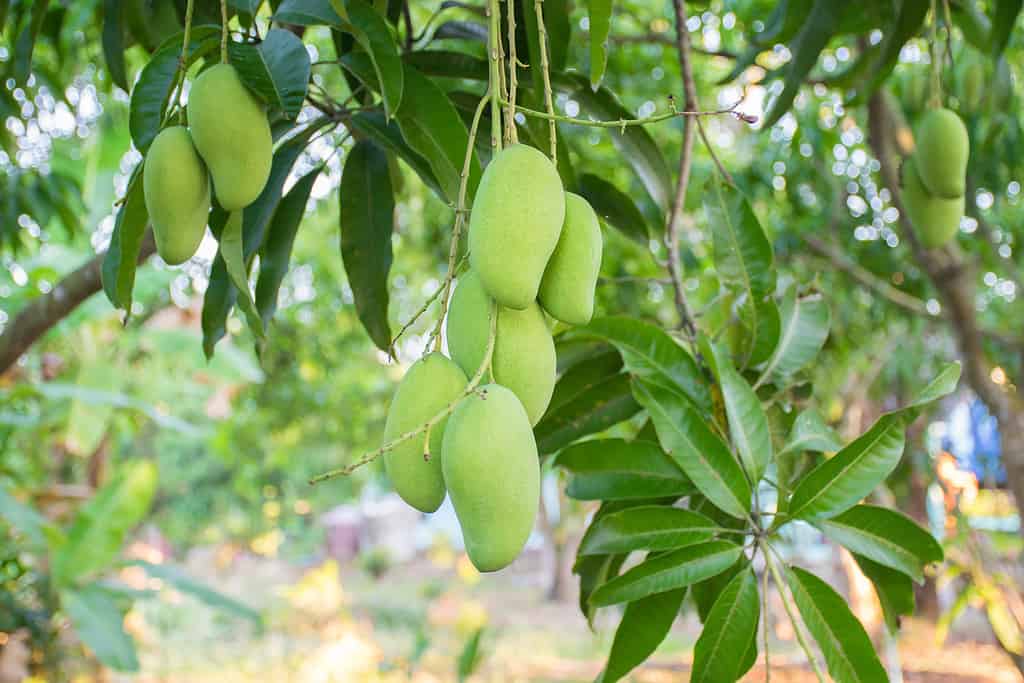
Mango trees grow up to 35 feet tall in Florida’s southern counties.
©Sai Tha/Shutterstock.com
This Florida evergreen fruit tree is famous for producing serious smoothies, salsa, and marinades. This fast-growing, tall, evergreen tree sports a large, thick canopy as high as 35 feet. Mango varieties dominate tree size, with some purposely kept smaller in height and width. This fruit tree produces elliptical and oval-shaped mango fruit blooms in hot weather in southern Florida’s tropical and sub-tropical temperatures. Mango fruit trees have thick green leaves and five-petal white blossoms at the end of the shoots.
9. Lychee
Litchi chinensis
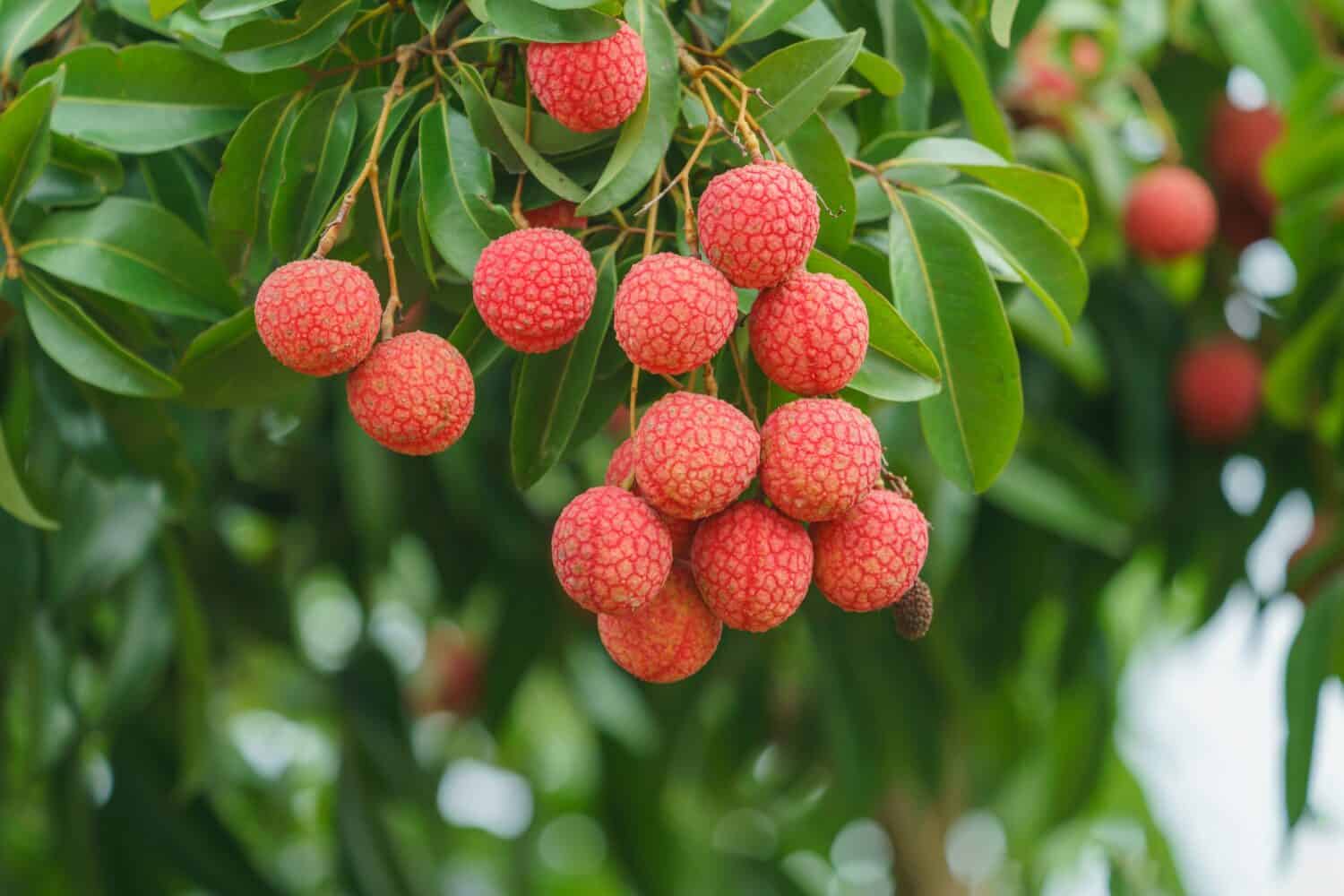
Lychee are among the tallest evergreen fruit trees in the Sunshine State, reaching up to 50 feet in height.
©Vietnam Stock Images/Shutterstock.com
One of the tallest Florida evergreen fruit trees is 30 to 50 feet. With a low draping canopy, the lychee grows hearty only at the southern most tip. It thrives off hot and humid weather when maturing in coastal areas. The fruit tree bears a fragrant and sweet combination of citrus and strawberry. While it may look like an overgrown red raspberry, like the starfruit, the lychee is not a kind and can be poisonous due to toxins affecting the kidneys and brain. This fruit tree flower is shooting pinnacles of light red, complementing the exotic fruit.
10. Pomegranate
Punica granatum
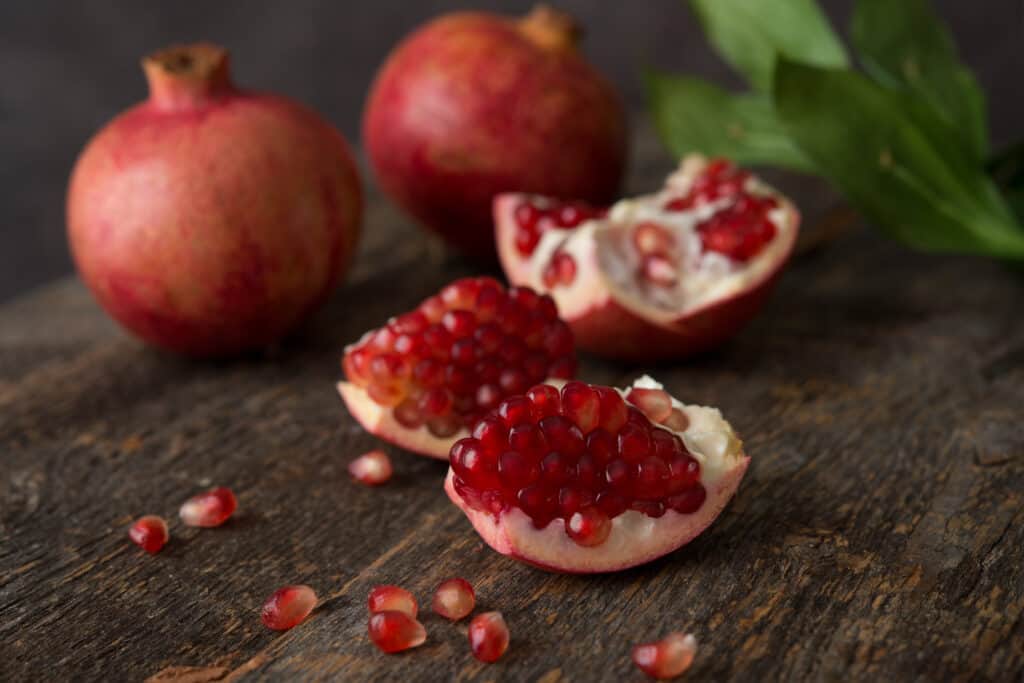
Pomegranate is popular for its health benefits.
©Gorenkova Evgenija/Shutterstock.com
The health benefits of this Punicaceae family fruit tree are popular among health experts. The bright red blooms of red balls stem from ornamental flowers spread out in a vast, dense bush canopy. Popular in Florida’s Panhandle, the pomegranate fruit tree is nearly a century old in the U.S. The fruit tree matures all year in the southern part of the state but blooms between July and November in north Florida. The fruit tree grows between 12 and 20 feet tall and sports thick, glossy leaves. Eaten raw or juiced; the pomegranate tree boasts super health benefits and a beautiful bloom.
| Tree | Height |
|---|---|
| Avocado | 15-30 feet |
| Carambola | 25-30 feet |
| Grapefruit | 15-20 feet |
| Lemon | 20 feet |
| Lime | 15-20 feet |
| Orange | 12-30 feet |
| Jackfruit | Up to 70 feet |
| Mango | 35 feet |
| Lychee | 30-50 feet |
| Pomegranate | 12-20 feet |
The photo featured at the top of this post is © iStock.com/MarinaVarnava
Thank you for reading! Have some feedback for us? Contact the AZ Animals editorial team.







